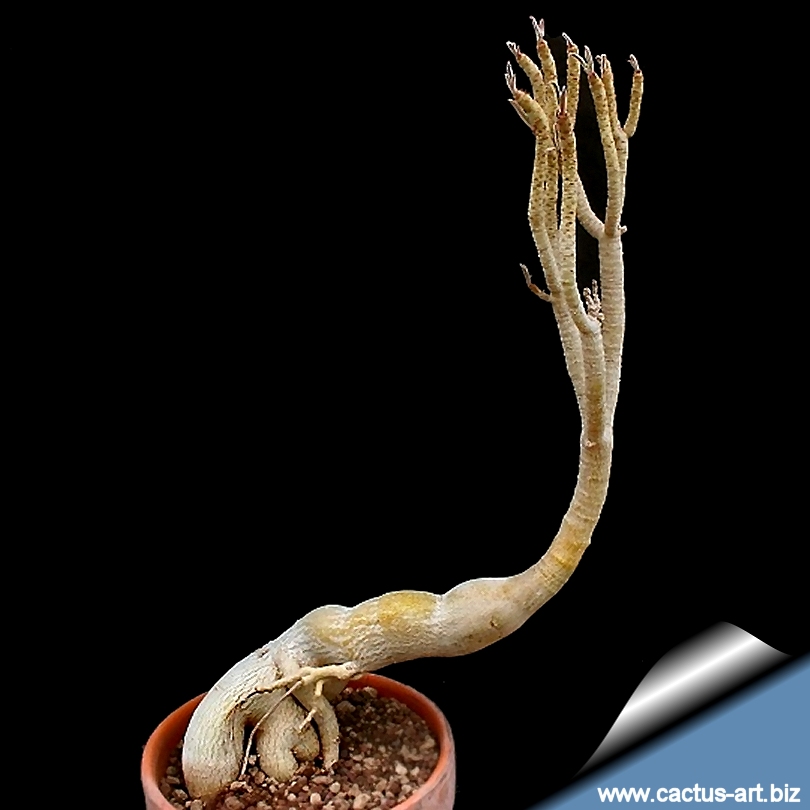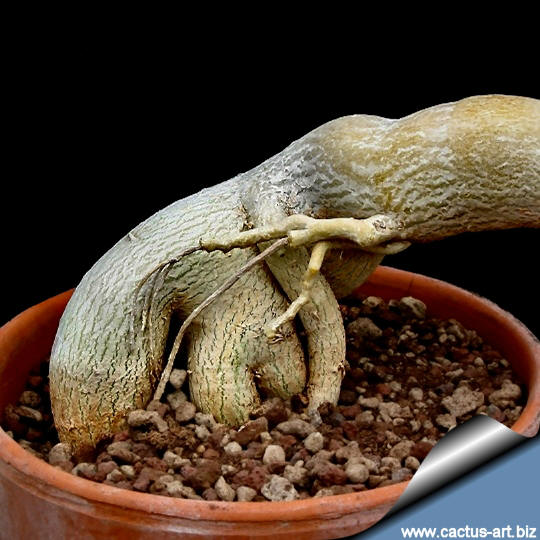|
|
|

A. swazicum (during winter rest)
This is supposed to be the hardiest Adenium. it is also a
very nice free blooming species with intense pink flowers borne in
masses that tends to have a longer flowering season than most of
the Adeniums.
well-developed plants have huge roots and thick trunks. |
|
Description: It is a dwarf shrub, up to 30 cm high, with an enlarged
succulent stem with few branches, sometimes partly below ground that
tend to droop or spread, especially in plants that are too shaded;
mature plants have massive roots and thick stems, but a caudex is
evident only in young ones.
Leaves: Long, narrow and succulent up to 13 cm long x 3 cm wide,
tapering to both ends or widest near the tips, often folded lengthwise
and usually slightly crisped (wavy), softly pubescent below, losing
hairs later without conspicuous veins ; lighter green than in most adeniums.
Flower: Uniformly coloured pink to deep reddish purple, average
6-7 cm in diameter, in terminal Inflorescence, appearing with
leaves. Blooming over a long season normally in late summer and
autumn (Some clones, however, are in almost continuous bloom,
experiencing only a few weeks of rest in late winter)
Hybrids: Adenium swazicum was used in
intergeneric hybrids with A. obesum and some of the most floriferous
hybrids belong to this group.
Photo of conspecific taxa, varieties, forms and
cultivars of plants belonging to theAdenium
obesum
complex :
|
|


Advertising
|
|
|
|
|
Family: Apocynaceae |
|
Scientific name: Adenium swazicum
Origin: Occurs on the east coast of southern Africa, in
Swaziland and adjacent parts of South Africa and Mozambique.
Synonyms:
- A. obesum ssp. swazicum (Stapf) G. D. Rowlwy
In: Repert. Pl. Succ. 29:3, 1980
-
A. boehmianum var. swazicum (Stapf)
Rowl.A
|
|
|
|
 Cultivation: A.swazicum is easy to grow but is
especially susceptible to spider mite infestation. It is nearly
evergreen if grown in a warm greenhouse or tropical conditions a and
watered, but can loose its leaves and forced into a long winter dormancy
in cooler climate. New growth begins early in spring.
It like pots with generous drain holes on sides and bottom, need a very
porous potting medium media (add pumice, vulcanite, and perlite) seeing
that the main trunk is planted with the majority of the roots below the
caudex line. Its rare that adeniums will use the upper third of their
soil and often this area serves like a mulch or support for the stem.
To make plants develop a large swollen base/trunk and to increase
flowering, they require a fertilizer rich in potassium and phosphorus
without a too high nitrogen content.
Bright filtered light is best but in areas where light is not as
burning, plants may be kept outdoors in full sun unprotected but
remember that caudex is very susceptible to sun scalding.
Water plants preferably in the early mornings until the soil is well
wetted and let excess water drains from the pot base. Watering can be
done as they become drier even daily or to every few days during active
growth season Never allow plants to dry out too often as this causes
them to go into early dormancy. Many plants simply never get enough
water to grow and flower adequately so keep them active and growing by
providing them with all the essential necessities.
Propagation: Seed, grafting or cuttings that develop the same
characteristics in a few years. |
|